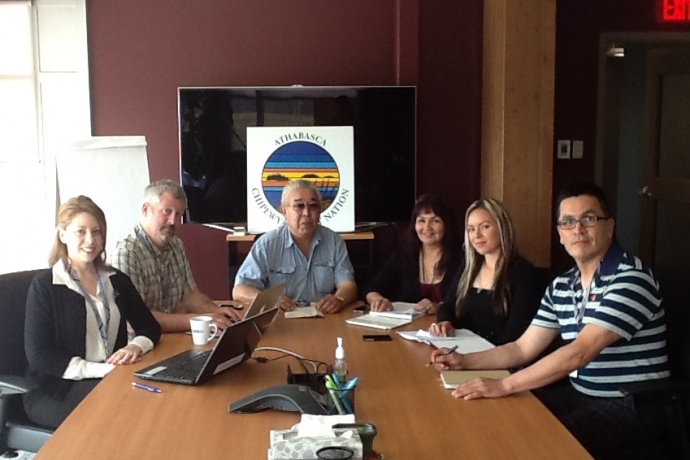Law student Vanessa Gurr, left, with staff at Industry Relations Corporation
By Karen Gross
From her base in remote Fort McMurray in northeastern Alberta, Vanessa Gurr is getting an up-close look at the energy sector, the people who power it and those who are fighting it. A recipient of the Callwood Fellowship in Aboriginal Law, Gurr is spending the summer working for the Athabasca Chipewyan First Nation (ACFN) and its Industry Relations Corporation. She's researching strategy for the band's legal challenge to Shell's development and expansion plans. "They're extremely busy," Gurr says. There are so many leases, so many prospective and ongoing projects, it's overwhelming sometimes."
Overwhelming but also exhilarating. Gurr is a Manitoba Métis, born in St. Boniface and raised in Winnipeg, Nunavut and the Northwest Territories. Prior to law school, she studied anthropology with a focus on the Inuit of Baffin Island. She also worked in Calgary in regulatory and environmental assessment.
The ACFN's biggest concerns are the cumulative effects of the development. What are the potential health concerns? What will be the impacts to the caribou and other keynote species?
"What they want me to do is research environmental monitoring programs," Gurr says. "The ACFN's biggest concerns are the cumulative effects of the development. What are the potential health concerns? What will be the impacts to the caribou and other keynote species?"
What Gurr has discovered during her time in the region has left her surprised and deeply disappointed. "I knew coming in that the Crown was failing to consult First Nations," she says. "I was prepared for hard bargaining. I wasn't quite prepared for the failure to consult, and what that looks like." Nor was she prepared, she says, for the sheer scope of the oil sands and their environmental impact. All of which have fueled her own commitment to work on the AFCN's behalf and fight to protect its interests as a signatory to Treaty 8.
"What I do draws upon my past experience in regulatory environmental assessment and anthropology. It all ties together," she says. "All that experience has set me on the path to do Aboriginal law, supporting the work of the First Nations."

